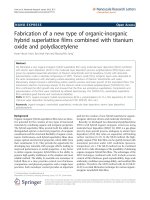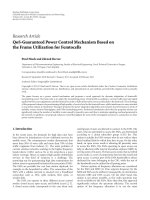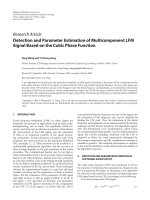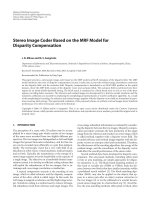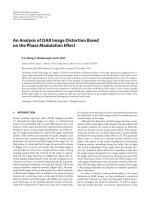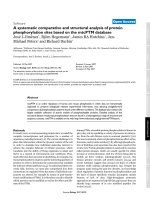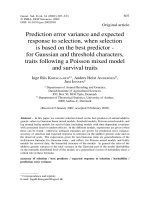Synthesis of organic–inorganic hybrids based on the conjugated polymer P3HT and mesoporous silicon
Bạn đang xem bản rút gọn của tài liệu. Xem và tải ngay bản đầy đủ của tài liệu tại đây (1.68 MB, 6 trang )
Microporous and Mesoporous Materials 343 (2022) 112155
Contents lists available at ScienceDirect
Microporous and Mesoporous Materials
journal homepage: www.elsevier.com/locate/micromeso
Synthesis of organic–inorganic hybrids based on the conjugated polymer
P3HT and mesoporous silicon
Natalia Gostkowska-Lekner a,b ,∗, Danny Kojda a , Jan-Ekkehard Hoffmann a , Manfred May c ,
Patrick Huber c,d,e , Klaus Habicht a,b , Tommy Hofmann a
a
Helmholtz-Zentrum Berlin für Materialien und Energie GmbH, Hahn-Meitner Platz 1, D-14109 Berlin, Germany
Institut für Physik und Astronomie, Universität Potsdam, Karl-Liebknecht-Str. 24-25, D-14476 Potsdam, Germany
c Hamburg University of Technology, Institute for Materials and X-ray Physics, Denickestr. 10, 21073 Hamburg, Germany
d Centre for Hybrid Nanostructures CHyN, University Hamburg, Luruper Chaussee 149, 22761 Hamburg, Germany
e
Centre for X-ray and Nano Science CXNS, Deutsches Elektronen-Synchrotron DESY, Notkestr. 85, 22607 Hamburg, Germany
b
ARTICLE
INFO
Keywords:
Mesoporous silicon
P3HT
Organic–inorganic hybrid
Melt infiltration
ABSTRACT
Organic–inorganic hybrids are a class of functional materials that combine favorable properties of their
constituents to achieve an overall improved performance for a wide range of applications. This article presents
the synthesis route for P3HT-porous silicon hybrids for thermoelectric applications. The conjugated polymer
P3HT is incorporated into the porous silicon matrix by means of melt infiltration. Gravimetry, sorption
isotherms and energy dispersive X-ray spectroscopy (EDX) mapping indicate that the organic molecules occupy
more than 50% of the void space in the inorganic host. We demonstrate that subsequent diffusion-based doping
of the confined polymer in a FeCl3 solution increases the electrical conductivity of the hybrid by five orders
of magnitude compared to the empty porous silicon host.
1. Introduction
Recent years saw the advent of conjugated polymers as promising
functional materials for organic electronics. Organic semiconductors
have received considerable attention in photovoltaics [1,2], photocatalysis [3,4], and optoelectronics [2,5]. They are also recognized as novel
thermoelectric materials [6–9].
Organic semiconductors attract attention due to their tunable optical and electronic properties [10,11]. Advantages over inorganic materials are cost effectiveness and easy processability [12]. Additionally,
their mechanical flexibility and lightweight allow for novel applications
like wearable electronics [13] that cannot be realized with inorganic,
heavy and rigid materials.
Several aspects challenge the large-scale implementation of
polymer-based electronic devices up to date. Promising polymers often lack long-term stability, which is for instance a prerequisite for
organic photovoltaics. Controlled doping and manufacturing reproducibility [14] are still challenging tasks. The lack of n-doped polymers [12] is of general concern. Overcoming these obstacles is a
formidable task for conceiving market-ready technologies.
The combination of organic soft-matter and inorganic materials
forms a bridge between conventional inorganic electronics and allpolymer based devices. The vision behind hybrids is to combine favorable properties of organic and inorganic constituents to enhance the
performance beyond simple compound averages.
Many studies discuss organic–inorganic hybrids from an applied
science point of view and cover a spectrum of topics [15–19], whose
high diversity can only be reviewed exemplarily.
Studies by Gélvez-Rueda and Sofos illustrate the potential of hybrids for solar-energy harvesting [17,18]. Gélvez-Rueda [17] improved
the charge-carrier separation in inorganic perovskite layers by incorporation of functional organic chromophores, whereas Sofos [18]
synthesized alternating lamellar ZnO-conjugated molecule hybrids with
improved photoconductive performance.
Improved thermoelectrics are promised by studies of Choi and
Wang [19,20]. Choi designed a ternary hybrid of graphene/polymer/
inorganic nanocrystal and observed double-carrier filtering at the two
heterojunctions [20]. Wang found an exceptionally high power factor
of 𝑃 𝐹 = 1350 μW m−1 K −2 in (PEDOT)/Bi2 Te3 hybrid films [19].
From a more fundamental point of view, functionalized molecules
or polymers embedded in rigid, inorganic nanostructures are role
models for nanoconfined soft matter. Their physical properties have
∗ Corresponding author at: Helmholtz-Zentrum Berlin für Materialien und Energie GmbH, Hahn-Meitner Platz 1, D-14109 Berlin, Germany.
E-mail address: (N. Gostkowska-Lekner).
/>Received 17 June 2022; Received in revised form 24 July 2022; Accepted 31 July 2022
Available online 13 August 2022
1387-1811/© 2022 The Author(s). Published by Elsevier Inc. This is an open access article under the CC BY license ( />
Microporous and Mesoporous Materials 343 (2022) 112155
N. Gostkowska-Lekner et al.
forces. It depends mainly on the pore radius, surface tension, contact
angle and viscosity. High degrees of pore filling can be achieved in a
single step [36,40,41].
This article’s description of the P3HT-pSi organic–inorganic hybrid
(OIH) synthesis by means of melt infiltration is organized as follows.
In the subsequent paragraphs, it describes the synthesis of pSi and
the melt imbibition of polymers into the porous host. It continues
with a discussion of the morphological properties of the synthesized
OIH’s before it highlights first measurements on electrical transport
properties.
to be carefully compared with the ones of their macroscopic bulk
counterparts as spatial confinement affects the physical properties of
soft matter [21,22] and consequently of the hybrids themselves. To
provide a few examples, confinement is responsible for more effective electropolymerization of polyaniline inside silica pores than on
bare ITO [23], modified chain orientations in pore-confined MEH-PPV
polymers, which lead to novel optical properties [24], and nanoconfinement induced chain alignment in poly (3-hexylotiophene) P3HT
during thermal nanoimprinting [25], which is of obvious relevance for
the inter-chain electronic conductance [14].
In this broad framework that motivates the synthesis of organic–
inorganic hybrids, our study finds its roots in the field of thermoelectrics [19,20]. Thermoelectric materials will play a key role in
a future energy infrastructure that is environmentally friendly and
sustainable. They convert thermal energy into electrical energy and vice
versa by means of Seebeck and Peltier effects. Large scale applications
are waste heat recovery and refrigeration. Small scale applications are
power supplies for wearable electronics in medical diagnostics or the
entertainment sector [26,27]. All visionary applications however necessitate novel materials that excel in their performance over existing ones.
In the ongoing effort to improve thermoelectric materials, organic–
inorganic hybrids emerge as a possibility to overcome the drawbacks of
conventional inorganic thermoelectrics that are the heavy weight, the
temperature range of application, a lack of abundance, the high costs
and often the need for toxic raw materials [28,29].
A distinct advantage of organic thermoelectrics is their flexibility
and easy processability. They allow for near-room temperature application, a region that is merely covered by other materials. Mesoporous
silicon exhibits intrinsically low thermal conductivity favorable for
thermoelectrics due to increased phonon scattering at the pore boundaries. Its impaired electrical conductivity is a drawback but could be
compensated by embedding conductive polymers with tunable electrical properties into the pore structure. Such hybrids could not only profit
from beneficial properties of its constituents but ideally from synergy
effects.
The motivations to use P3HT and pSi originate in their physical
properties and more technical considerations like low complexity in
synthesis. P3HT exhibits an exceptionally high charge carrier mobility [30], which can be enhanced by a factor of 20 upon chain
alignment inside straight nanopores [31]. Solution and melt-based
synthesis routes are favored by P3HT’s solubility in chloroform, 2chlorotoluene and toluene [32] and its low melting temperature of
𝑇 = 510 K [33].
Mesoporous silicon is a form of structured silicon characterized
by nanometer-sized voids [34] in a crystalline Si matrix. It comes
along with the promise to benefit from the technologically most advanced semiconductor industry of the arguably defining semiconductor
material of the 20th and 21th century.
PSi is fabricated by electrochemical anodization in hydrofluoric acid
(HF) based electrolytes. Pores in pSi are several tens of nanometers
across and form networks with channels preferentially aligned along
a particular crystallographic axis.
There are different strategies to fill the pores of pSi or, in general,
nanostructured hosts with functionalized molecules. Wet-processing
techniques such as dip-coating [35] are common approaches to incorporate polymers utilizing polymer solutions. Big challenges however
are achieving homogeneous pore fillings as the removal of the solvent
may cause redistribution of the active phase [36] and reaching a high
degree of pore fillings for polymers with a large radius of gyration,
respectively with low solubility.
Electropolymerization of monomers directly inside the pores [37–
39] is a challenging bottom-up technique to fill pores with polymers
of low solubility, large radius of gyration or polymers that dissociate
before the melting point is reached.
Melt infiltration is conceptually the simplest approach. The viscous
flow of the polymer melt into the pore channel is triggered by capillary
2. Experimental
2.1. Synthesis of mesoporous silicon
Mesoporous silicon is synthesized by means of electrochemical anodization in hydrofluoric acid (HF) based electrolytes. The source
materials are single-crystalline boron-doped [100] Si wafers with a
resistivity of 𝜌 = 0.01 − 0.02 Ω cm.
For electrochemical etching, we utilize a novel, custom-built anodization cell designed by Gostkowska-Lekner [42]. Electrolyte composition and anodization current are key synthesis parameters. Membranes for this study are anodized in HF/ethanol solution (HF(48 wt.%)
: C2 H6 O (99.9 wt.%) = 4:6) with a constant current density of 𝑗 =
13 mA cm−2 . An anodization time of 5 h leads to the growth of a 200 μm
thick epilayer on the bulk Si wafer with pores roughly 9 nm across. The
anodization ends with an increased current density of 𝑗 = 52 mA cm−2
for 40 s to detach the epilayer from the wafer and to obtain a selfsupporting pSi-membrane.
2.2. Polymer infiltration into mesoporous Si
The regioregular (>90%) P3HT powder with low molecular weight
𝑀𝑤 = 2.0 × 104 − 4.5 × 104 g mol−1 was purchased from Sigma Aldrich™
and used as received. Adopting low molecular weight P3HT with a
small radius of gyration reduces potential pore clogging [35].
The as-etched pSi membrane is heated up to 550 K, a temperature
well above the melting point of P3HT (𝑇 = 510 K). The polymer
powder placed on top of the heated membrane melts and flows into the
nanochannels due to capillary forces [33]. The inset of Fig. 3 shows a
sketch of the polymer imbibition in pSi.
The polymer flow in the nanochannels is an exceptionally slow
process due to the high viscosity of the polymer liquid (99 Pa s) [43]. It
takes up to 48 h to fill the pores of the membranes as discussed below
in detail. After cooling to room temperature a residual P3HT layer is
readily removed with a cotton pad and chloroform.
One should also note that the entire imbibition procedure is conducted in a glove box in an inert nitrogen atmosphere to avoid polymer
oxidation and degradation upon exposure to illumination in air [44].
Conjugated polymers in their neutral stable state conduct electricity
rather poorly. It is of importance to improve their electrical conductivity by means of doping to compete with the traditional inorganic
semiconductors [45]. Solution-based chemical doping is one of the most
popular and straightforward methods to incorporate counter ions into
the polymer structure.
Synthesized hybrids are doped by immersion in saturated FeCl3
chloroform solutions for 48 h or 72 h. The doping procedure takes place
in a glove box under inert atmosphere.
P3HT doping prior to infiltration may cause unfavorable polymer
aggregation. Solution doping after polymer infiltration bypasses any
change in melt infiltration dynamics due to polymer morphological
variation. The diffusion of Fe and Cl atoms into the confined polymer
is further discussed in Section 3.4.
2
Microporous and Mesoporous Materials 343 (2022) 112155
N. Gostkowska-Lekner et al.
particular its depth profile from the membrane surface to the end of
the propagating liquid polymer front.
One can define a degree of polymer filling 𝑓𝑝𝐸𝐷𝑋 by means of the
EDX signal depth profiles 𝐼 𝐸𝐷𝑋 (𝑥). Assuming that the EDX signal for
selected elements is proportional to the amount of polymer in the
pores and assuming that the pores on top of the membranes are filled
completely, one obtains
𝑓𝑝𝐸𝐷𝑋 =
∫ 𝐼 𝐸𝐷𝑋 (𝑥)𝑑𝑥
𝐼 𝐸𝐷𝑋 (0) ∫ 𝑑𝑥
.
(1)
Gravimetry provides an alternative, quantitative estimate of the
degree of polymer filling in the membranes. The weight of the empty
membrane 𝑚𝑒 , the weight of the filled membrane 𝑚𝑓 and the pore
volume 𝑉𝑝 as obtained from the sorption isotherm predict a polymer
filling 𝑓𝑝𝑔𝑟𝑎𝑣 of
𝑓𝑝𝑔𝑟𝑎𝑣 =
𝑚𝑓 − 𝑚𝑒 1
.
𝜌𝑃 3𝐻𝑇 𝑉𝑝
(2)
The sorption isotherms of hybrids are also used to estimate the
degree of filling. Estimating the empty pore volume 𝑉𝑝 from sorption
isotherms that are measured prior and post filling results in an polymer
filling fraction 𝑓𝑝𝑖𝑠𝑜 of
𝑓𝑝𝑖𝑠𝑜 = 1 −
𝑉𝑝𝑝𝑜𝑠𝑡
𝑉𝑝𝑝𝑟𝑖𝑜𝑟
.
(3)
It is important to note that the polymer can block the access to smaller
pores in the pore structure thus preventing the nitrogen to enter.
The values of pore volume in this case would be underestimated,
consequently the filling fraction overestimated.
Fig. 1. (a) N2 sorption isotherm of as-etched pSi at 𝑇 = 77 K. (b) Pore-size distribution
of as-etched membrane (open symbols) and vacant pore space after polymer imbibition
(black symbols).
2.3.3. Electrical transport
The electrical conductivity 𝜎(𝑇 ) of the OIH samples is measured
with an in-line four-probe technique using a commercial SBA 458
device (NETZSCH-Gerätebau GmbH) in the temperature range from
300 K to 373 K. Electrical contacts to inject a current of maximum 1 mA
and to probe the voltage are placed on the cleaned sample side, that
faced the polymer melt. 𝜎(𝑇 ) is measured in helium atmosphere directly
after transferring the samples from the glove box to the SBA device.
2.3. Characterization methods
2.3.1. pSi morphology
Nitrogen sorption isotherms are employed to characterize the morphology of mesoporous materials [46]. Isotherms probe the volumetric
uptake of liquid nitrogen 𝑓 (𝑃 ∕𝑃0 ) = 𝑁∕𝑁0 inside the pore space at
𝑇 = 77 K as the reduced pressure 𝑃𝑟𝑒𝑑 = 𝑃 ∕𝑃0 of the coexisting
gas phase is step-wise changed. Here, 𝑁 is the number of nitrogen
molecules physisorbed and 𝑁0 the number of molecules required to fill
the pore volume completely. 𝑃 and 𝑃0 refer to equilibrium pressure of
the confined liquid and saturation pressure of the bulk liquid.
The uptake as function of the reduced pressure 𝑃𝑟𝑒𝑑 follows typically
a hysteresis path upon adsorption and desorption (Fig. 1a). Multilayer
formation on the pore walls at small reduced pressure is followed by
capillary condensation at higher 𝑃𝑟𝑒𝑑 with condensed liquid in the
pore center. The physisorption data provide the pore-size distribution, effective surface area and porosity of the substrate by means of
Brunauer–Emmet–Teller [47] and Barrett–Joyner–Halenda [48] analysis.
3. Results and discussion
This section discusses the morphology of as-etched as well as
polymer-filled porous silicon membranes. The filling-factor determined
with the methods presented in Section 2.3.2 is discussed. Filling-factor
data of seven hybrids are presented to show the reproducibility of the
synthesis.
3.1. As-etched membranes
The quantitative analysis of the N2 sorption isotherms reveals a
pore-size distribution in as-etched pSi membranes that centers around
an average radius of 𝑅 ≈ 4.5 nm with a standard deviation of not more
than 𝜎(𝑅) = 11% (Fig. 1b). The porosity of the membranes is about 60%
at a specific surface of 𝐴 = 382 m2 g−1 .
2.3.2. Polymer imbibition
Scanning electron microscopy (SEM) imaging is combined with
energy dispersive X-ray spectroscopy (EDX) mapping utilizing a LEO
GEMINI 1530 UltraPlus (Zeiss) electron microscope. It provides a direct
visualization of the polymers in pSi (Fig. 3). Whereas SEM allows
probing the morphology of the pSi cross-section itself, the EDX mapping
identifies specific elements such as sulfur, carbon, iron or chloride
in the probed region. Some of these elements are characteristic for
the polymer only, e.g. sulfur. This element selectivity is exploited to
reveal the polymer distribution in the membrane. It reveals (Fig. 3) in
Fig. 2 shows a SEM micrograph of the pSi cross-section. The channels in mesoporous silicon are preferentially aligned along the [100]
direction but exhibit numerous dendritic side branches that lead to an
interconnected pore network [49]. Wider pores are interconnected via
smaller channels.
3
Microporous and Mesoporous Materials 343 (2022) 112155
N. Gostkowska-Lekner et al.
Fig. 2. SEM micrograph of the pSi cross-section along the [100] direction.
Fig. 3. PSi membrane partially filled with P3HT: Sample cross section and EDX sulfur
signal (symbols) as function of depth. The membrane was etched for 6 h. The blue color
indicates the filling region. The inset sketches the polymer flow into the pore space.
(For interpretation of the references to color in this figure legend, the reader is referred
to the web version of this article.)
3.2. Hybrids
Sorption isotherms, gravimetry and EDX spectroscopy stringently
prove the successful physisorption of P3HT in the vacant pore space of
pSi during the imbibition process. Fig. 1b is derived from the isotherms
and already indicates that P3HT occupies roughly 50% of the pore
space. A more quantitative analysis based on Eq. (3) confirms this
qualitative assessment (see Table 1).
The degree of polymer filling obtained from the sorption isotherms
is biased by pore clogging. The dendritic growth of the pores comes
along with bottle necks between wider pores. These bottle necks and
consequently some connected pores are not filled during imbibition. In
particular, isolated islands of empty pore space within the otherwise
filled substrate form. The volume of these islands is not probed by
the N2 isotherms due to a lack of access over the filled pore network.
Therefore, 𝑓𝑝𝑖𝑠𝑜 is prone to overestimating the degree of pore filling.
Gravimetry provides no such uncertainty. The filling fractions 𝑓𝑝𝑔𝑟𝑎𝑣
for selected samples based on Eq. (2) is around 40% < 𝑓𝑝𝑔𝑟𝑎𝑣 < 50%
as seen in Table 1. These values are marginally lower than the ones
obtained from sorption isotherms.
EDX spectroscopy provides the most striking proof for successful
P3HT imbibition. By the very design of the conceived synthesis route,
the polymer melt flows into the pore network from the top of the
membrane and a liquid polymer front propagates along the [100]
crystallographic direction. As an instructive illustration, Fig. 3 shows
the polymer filling at an intermediate state after 7 h.
The EDX sulfur signal, which is characteristic for the presence of
P3HT, clearly evidences that the membrane is filled up to a depth of
80 μm and the sharp transition between filled and empty pSi is evident.
In contrast, Fig. 4 indicates the presence of P3HT across the entire
membrane after an imbibition time of 48 h.
The degree of filling based on the EDX signal appears less reliable
than the one obtained by gravimetry and isotherms. To estimate the
filling factor with EDX, the sulfur signal is integrated over the crosssection and normalized to the signal at the top of the membrane
multiplied with the membrane thickness.
However, the underlying assumption, namely that the signal at the
top of the membranes represents complete filling has to be taken with
caution. It is experimentally almost inevitable to probe part of the
membrane surface along the first few microns of the depth scan and
consequently to overestimate 𝐼 𝐸𝐷𝑋 (0).
As a result, filling fractions presented in Table 1 show roughly a
factor of two decrease in filling compared to other methods. However,
one might entertain the idea to properly calibrate the EDX signal with
a gravimetric reference measurement.
It appears that the gravimetrically determined amount of pSi pore
volume occupied by P3HT is the most accurate one. Together with
nitrogen sorption isotherm measurements and SEM/EDX mapping there
is no doubt about a successful infiltration of P3HT polymer into the
mesoporous silicon membranes.
Some additional insights are gained from the fact that the strength
of the sulfur signal decays continuously across the membrane. The
most appealing explanation is that the imbibition involves two different
time-scales [33,40]. In this scenario, the polymer melt wets the pore
walls on a ‘‘fast’’ time scale as it creeps along the pore surfaces through
the channels while the center remains empty. Then on a significantly
‘‘slower’’ time scale polymer in the pore center follows this precursor
film.
In a less sophisticated explanation, one would assume that the
polymer flow is increasingly impaired by bottle necks in the channels as
the liquid front propagates along the pores. This could readily lead to a
depth gradient in the polymer distribution and consequently a decaying
EDX sulfur signal.
3.3. Reproducibility
An extended set of hybrids was synthesized under equal conditions.
In particular, the infiltration time was always 48 h. These samples show
no major difference in the filling factor (Table 1) and the polymerspecific EDX signals exhibit always the same decay characteristics as
function of depth. As such, the discussed synthesis routes appear robust
with highly reproducible outcome.
3.4. Doped hybrids
EDX mapping of the doped hybrids shows successful incorporation
of FeCl3 dopant atoms into the polymer matrix. In the element map of
Fig. 4 one can distinguish the distribution of silicon, sulfur, iron and
chlorine as a result of the discussed synthesis approach.
It is remarkable, that the signals from iron and chlorine which are
characteristic of the dopant exhibit exactly the same decaying profile
along the pore channels as the sulfur signal which is characteristic for
the polymer. This clearly indicates successful diffusion of the doping
agents into the polymer matrix contrary to physisorption of the FeCl3
simply onto silicon pore walls or vacant pore space.
4
Microporous and Mesoporous Materials 343 (2022) 112155
N. Gostkowska-Lekner et al.
Fig. 5. Electrical conductivity of FeCl3 doped hybrid and as-etched pSi. Inset: Arrhenius
plot of as-etched membrane. The red dashed line is extrapolated from measurement data
at high temperature (square symbols). The blue horizontal line marks the sensitivity
limit of the device. (For interpretation of the references to color in this figure legend,
the reader is referred to the web version of this article.)
Fig. 4. Doped pSi-P3HT hybrid (48 h): EDX signals (symbols) of silicon, sulfur (P3HT),
chlorine (dopant) and iron (dopant). The vanishing sulfur signal in the empty pSi
membrane serves as reference. The background shows the membrane cross section.
Table 1
Filling factor for 48 h infiltration time: comparative characterization based on sorption
isotherms, gravimetry, and EDX cross-section scan.
3.5. Electronic transport
Electrical conductivity measurements on OIHs were performed in
the temperature range between 𝑇 = 300 K and 𝑇 = 370 K. In Fig. 5
a very low electrical conductivity is evident for the pSi matrix. Below
400 K the conductivity is even below the sensitivity limit of the used
device that is 𝜎 = 0.05 Ω−1 cm−1 and shown data are a low temperature extrapolation. Assuming a thermally activated behavior the
extrapolated data for room temperature conductivity is 𝜎(𝑇 = 300 K) =
10−4 Ω−1 cm−1
Preceding studies by Lee et al. [50] indicate for porous silicon with
corresponding porosity a conductivity between 𝜎 < 10−4 −10−3 Ω−1 cm−1
in the temperature range from 𝑇 = 300 K to 𝑇 = 370 K. Compared with
these studies and our low temperature extrapolation, the conductivity
of the selected hybrids is remarkably increased by five orders of magnitude compared to pSi in the same 𝑇 −range. It is 𝜎(𝑇 = 300 K) =
13 Ω−1 cm−1 .
Additionally to this phenomenal increase in conductivity, it is also
intriguing to note the different temperature dependence of the electrical conductivity. As the inset in Fig. 5 shows, the electrical conductivity
in pSi is thermally activated. It increases exponentially with temperature. On the contrary, the electrical conductivity of OIHs decreases
with temperature. This contrast resembles the situation encountered in
undoped and doped semiconductors.
It is up to subsequent studies to interpret the temperature dependent
conductivity of pSi and OIH’s in detail. The exponentially increased
conductivity in pSi might be explained in terms of 𝑇 -dependent free
charge-carrier densities and phonon-assisted carrier hopping. Complementary measurements of OIHs Hall-mobility will show whether the
decreasing conductivity in hybrids relates to increased carrier scattering at elevated temperatures. Seebeck coefficient measurements will
provide more comprehensive insights into charge transport and the
improved performance of the OIH.
Small area samples (>50 mm2 ):
Sorption isotherm
Gravimetry
EDX
Hybrid 1
Hybrid 2
49,8%
55%
41%
45%
19%
21%
–
–
–
–
–
55%
52%
50%
45%
37%
30%
31%
28%
22%
19%
Large area samples (<50 mm2 ):
Synthesized for SBA measurements
Hybrid
Hybrid
Hybrid
Hybrid
Hybrid
3
4
5
6
7
We have demonstrated in this mindset successful synthesis of hybrids based on P3HT conductive polymer and free standing 200 μm
thick porous silicon. Organic molecules are introduced into 9 nm wide
pores by means of melt infiltration. Sorption isotherm, gravimetry and
EDX mapping convincingly show that the P3HT occupies roughly 50%
of the pore space. Upon polymer doping with FeCl3 , the electrical
conductivity of the resulting hybrid is significantly enhanced compared
to mesoporous silicon.
As the project goes on, one must focus on the link between microscopic structure and thermoelectric functionality of the successfully
synthesized hybrids. These investigations are a prerequisite for any
meaningfully devised application. The measurement of electrical and
thermal conductivity, Hall mobility and Seebeck effect will provide a
full thermoelectric characterization of the hybrids. X-ray and neutron
scattering techniques come to mind providing information on an ultrastructural level. They are suited to identify the morphology of the
polymer in the confining host – a significant parameter that defines its
functionality – and they should be able to probe the structure of the
polymer/silicon interfaces as important for charge and heat transport
through the hybrid. Scattering studies might be complemented by TEM
characterization and solid-state NMR. In a nutshell, one can conclude
that tempting experiments are ahead.
The results from our fundamental studies on the hybrids provide a
sound basis to help understanding the basic functionality of this new
material class. In particular, they will help to evaluate the potential of
organic–inorganic hybrids for thermoelectrics. Whether the envisioned
4. Conclusions and outlook
The presented study is a very first step in an ambiguous attempt
to synthesize organic–inorganic thermoelectric hybrids and to fundamentally understand their thermoelectric transport properties on a
macroscopic and microscopic level.
5
Microporous and Mesoporous Materials 343 (2022) 112155
N. Gostkowska-Lekner et al.
application as energy converter or small-scale electronics will find
industrial approval requires further studies, demonstrating upscaling of
the synthesis routes for large scale production, as well as a thorough
evaluation of device performance.
[13] P.C.Y. Chow, T. Someya, Adv. Mater. 32 (2020) 1–26.
[14] H. Peng, X. Sun, W. Weng, X. Fang, Polymer Materials for Energy and Electronic
Applications, Elsevier, 2017.
[15] Y. Du, S.Z. Shen, K. Cai, P.S. Casey, Prog. Polym. Sci. 37 (2012) 820–841.
[16] S.H. Mir, L.A. Nagahara, T. Thundat, P. Mokarian-Tabari, H. Furukawa, A.
Khosla, J. Electrochem. Soc. 165 (2018) B3137–B3156.
[17] M.C. Gélvez-Rueda, M.B. Fridriksson, R.K. Dubey, W.F. Jager, W. van der Stam,
F. Grozema, Nature Commun. 11 (2020) 1–9.
[18] M. Sofos, J. Goldberger, D.A. Stone, J.E. Allen, Q. Ma, D.J. Herman, L.J. Tsa2,
W.-W. Lauhon, S.I. Samuel I. Stupp, Nature Mater. 8 (2009) 68–75.
[19] L. Wang, Z. Zhang, Y. Liu, B. Wang, L. Fang, J. Qiu, K. Zhang, S. Wang, Nature
Commun. 9 (2018) 1–8.
[20] J. Choi, J. Lee, S.-S. Lee, C. Park, H. Kim, Adv. Energy Mater. 6 (2016) 1–8.
[21] P. Huber, J. Phys.: Condens. Matter 27 (2015).
[22] O. Gang, P. Huber, A. Karim, I. Zvonkina, S.-W. Lee, J.-W. Kim, D.K. Roper,
W.J. Li, Soft Matter and Biomaterials on the Nanoscale, Vol. 1, World Scientific,
2020.
[23] F. Montilla, M.A. Cotarelo, E. Morallon, J. Mater. Chem. 19 (2009) 305–310.
[24] I.B. Martini, I.M. Craig, W.C. Molenkamp, H. Miyata, S.H. Tolbert, B.J. Schwartz,
Nature Nanotechnol. 2 (2007) 647–652.
[25] M. Aryal, K. Trivedi, W. Hu, ACS Nano 3 (2009) 3085–3090.
[26] A. Dahiya, F. Morini, S. Boubenia, K. Nadaud, D. Alquier, G. Poulin-Vittrant,
Adv. Mater. Technol. 3 (2018) 1700249.
[27] C. Xin, Z. Hu, Z. Fang, M. Chaudhary, H. Xiang, X. Xu, L. Aigouy, Z. Chen,
Mater. Today Energy 22 (2021) 100859.
[28] H. Jin, J. Li, J. Iocozzia, X. Zeng, P.-C. Wei, C. Yang, N. Li, Z. Liu, J. Hau He,
T. Zhu, J. Wang, Z. Lin, S. Wang, Angew. Chem. 58 (2019) 15206–15226.
[29] M. Kemerink, C. Müller, M.L. Chabinyc, M. Brinkmann, Appl. Phys. Lett. 119
(2021) 260401.
[30] H. Sirringhaus, P. Brown, R. Friend, M.M. Nielsen, K. Bechgaard, B.M.W.
Langeveld-Voss, A.J.H. Spiering, R.A.J. Janssen, E.W. Meijer, P. Herwig, D.M.
de Leeuw, Nature 401 (1999) 686–688.
[31] K.M. Coakley, B.S. Srinivasan, J.M. Ziebarth, C. Goh, Y. Liu, M.D. McGehee, Adv.
Funct. Mater. 15 (2005) 1927–1932.
[32] M. Roesing, J. Howell, D. Boucher, J. Polym. Sci. B: Polym. Phys. 55 (2017)
1075–1087.
[33] J. Martín, A. Nogales, M. Martín-González, Macromolecules 46 (2013)
1477–1483.
[34] V. Lehmann, R. Stengl, A. Luigart, Mater. Sci. Eng. B 69 (2000) 11–22.
[35] S.L. Lim, Y. Liu, G. Liu, S.Y. Xu, H.Y. Pan, E.-T. Kang, C.K. Ong, Phys. Status
Solidi (A) 208 (2011) 658–663.
[36] P.E. De Jongh, T.M. Eggenhuisen, Adv. Mater. 25 (2013) 6672–6690.
[37] D. Kowalski, P. Schmuki, Chem. Commun. 46 (2010) 8585–8587.
[38] N.C. Strandwitz, Y. Nonoguchi, S.W. Boettcher, G.D. Stucky, Langmuir 26 (2010)
5319–5322.
[39] M. Brinker, G. Dittrich, C. Richert, P. Lakner, T. Krekeler, T.F. Keller, N. Huber,
P. Huber, Sci. Adv. 6 (2020) 1–8.
[40] L.G. Cencha, G. Dittrich, P. Huber, C.L.A. Berli, R. Urteaga, Phys. Rev. Lett. 125
(2020) 234502.
[41] F. Vazquez Luna, M. Gerstenberger, G. Dittrich, J. Martins de Souza e Silva, P.
Huber, R. Wehrspohn, M. Steinhart, J. Phys. Chem. C 125 (2021) 26731–26743.
[42] N. Gostkowska-Lekner, D. Wallacher, N. Grimm, K. Habicht, T. Hofmann, Rev.
Sci. Instrum. 91 (2020) 1–6.
[43] J. Fanous, M. Schweizer, D. Schawaller, M. Buchmeiser, Macromol. Mater. Eng.
297 (2012) 123–127.
[44] S. Cook, A. Furubea, R. Katoh, J. Mater. Chem. 22 (2012) 4282–4289.
[45] P. Kar, Doping in Conjugated Polymers, Wiley, 2013.
[46] M. Thommes, K. Kaneko, A. Neimark, J. Olivier, F. Rodriguez-Reinoso, J.
Rouquerol, K. Sing, Pure Appl. Chem. 87 (2015) 1051–1069.
[47] S. Brunauer, P.H. Emmett, E. Teller, J. Am. Chem. Soc. 60 (1938) 309–319.
[48] E.P. Barrett, L.G. Joyner, P.P. Halenda, J. Am. Chem. Soc. 73 (1951) 373–380.
[49] R. Smith, S. Collins, J. Appl. Phys. 71 (1992) R1–R22.
[50] W.H. Lee, C. Lee, J. Jang, J. Non-Cryst. Solids 198–200 (1996) 911–914.
CRediT authorship contribution statement
Natalia Gostkowska-Lekner: Writing – review & editing, Writing
– original draft, Methodology, Investigation, Formal analysis, Conceptualization. Danny Kojda: Writing – review & editing, Methodology.
Jan-Ekkehard Hoffmann: Writing – review & editing, Methodology.
Manfred May: Writing – review & editing, Methodology. Patrick Huber: Writing – review & editing, Project administration. Klaus Habicht:
Writing – review & editing, Writing – original draft, Supervision, Resources. Tommy Hofmann: Writing – review & editing, Writing –
original draft, Supervision, Resources, Project administration, Formal
analysis, Conceptualization.
Declaration of competing interest
The authors declare that they have no known competing financial interests or personal relationships that could have appeared to
influence the work reported in this paper.
Data availability
Data will be made available on request.
Acknowledgments
We thank the DFG, Germany for funding the project Hybrid thermoelectrics based on porous silicon: Linking Macroscopic Transport Phenomena to Microscopic Structure and Elementary Excitations, project
number 402553194.
References
[1] H. Bin, L. Gao, Z.-G. Zhang, Y. Yang, Y. Zhang, C. Zhang, S. Chen, L. Xue, C.
Yang, M. Xiao, Y. Li, Nature Commun. 7 (2016) 1–11.
[2] U.-Y. Cheng, S.-H. Yang, C.-S. Hsu, Chem. Rev. 109 (2009) 5868–5923.
[3] B. Muktha, G. Madras, T.N. Guru Row, U. Scherf, S. Patil, J. Phys. Chem. B 111
(2007) 7994–7998.
[4] M. Zhanga, X. Wang, Energy Environ. Sci. 7 (2014) 1902–1906.
[5] C.R. McNeill, N.C. Greenham, Adv. Mater. 21 (2009) 3840–3850.
[6] M. Bharti, A. Singh, S. Samanta, D.K. Aswal, Prog. Mater. Sci. 93 (2018)
270–310.
[7] B. Russ, A. Glaudell, J. Urban, M.L. Chabinyc, R.A. Segalman, Nat. Rev. Mater.
1 (2016) 1–14.
[8] H. Yao, Z. Fan, H. Cheng, X. Guan, C. Wang, K. Sun, J. Ouyang, Macromol.
Rapid Commun. 37 (2018) 1–22.
[9] G. Kim, L. Shao, K. Zhang, K.P. Pipe, Nature Mater. 12 (2013) 719–723.
[10] I. Piquero-Zulaica, A. Garcia-Lekue, L. Colazzo, C.K. Krug, M.S.G. Mohammed,
Z.M. Abd El-Fattah, J.M. Gottfried, D.G. De Oteyza, J.E. Ortega, J. Lobo-Checa,
ACS Nano 12 (2018) 10537–10544.
[11] H. Masai, J. Terao, Polym. J. 49 (2017) 805–814.
[12] J.A. Rivera, A.C. Castillo, M.D.L.L.M. Gonzalez, Organic semiconductors, in:
Semiconductors, Springer Nature, Switzerland, 2019.
6

